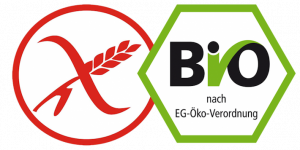
Apr
Abdominal pain, tiredness, feeling ill, digestive problems, skin and weight problems and hair loss can all indicate one thing: Gluten intolerance or, in serious cases, coeliac disease. But how do you recognise coeliac disease and what is gluten? Do you need gluten for a healthy diet?
What is gluten? The word gluten refers to grain protein, which is found in wheat, rye, spelt, barley, oats, green spelt, ancient grains and other types of grain. Gluten is primarily used in the kitchen and food industry as an adhesive - without gluten, bread and baked goods, for example, become hard and dry and crumble apart. Avoiding gluten is not a cause for concern, even for gluten-tolerant people: gluten has only a very low nutritional value, and avoiding it can prevent deficiency symptoms. So if you avoid gluten, you don't have to worry about deficiency symptoms.
What is coeliac disease? Coeliac disease and the less drastic gluten intolerance are a disease of the small intestine. The human small intestine has small villi that look like small tubes. These villi absorb the nutrients from food. In coeliac disease, the villi of the small intestine become inflamed and regress. This results in unpleasant to very painful symptoms, but also a reduction in nutrient absorption.
How do you recognise coeliac disease or gluten intolerance? The signs of gluten intolerance can be clear or diffuse and vary from person to person and also depend on age.
Babies and small children can react to gluten just like adults. Typical signs of an intolerance in the first few months and years are low body weight, diarrhoea, tearfulness, loss of appetite, bloated stomach, pallor and muscle and concentration weakness.
School-age children can react to gluten with diarrhoea, a bulging stomach, constipation, short stature, problems with tooth enamel and delayed puberty.
In adolescents and adults, the symptoms are much more diffuse. In addition, adults have often lived with an intolerance for so long that they perceive the symptoms as normal. These symptoms occur particularly often in connection with gluten intolerance: General exhaustion, fatigue, prolonged or permanent feeling of illness, weakness, diarrhoea and/or constipation, flatulence, loss of appetite and/or feeling hungry, nausea, vomiting, concentration problems, skin problems, irregular menstrual cycle, osteoporosis, vitamin deficiency due to reduced nutrient intake, anaemia and many more.
What now? If coeliac disease or gluten intolerance is suspected, there is a simple initial test: leave out all gluten-containing foods for a while and observe whether the symptoms improve after a possible initial aggravation. Serological tests (blood tests) and a biopsy of the small intestine can provide certainty. However, these methods can only detect coeliac disease; even a pronounced intolerance cannot be reliably detected in this way.
Is gluten unhealthy? Gluten is a natural component of some types of grain and is therefore not fundamentally unhealthy. Lifestyle and wellness guides repeatedly recommend avoiding gluten in order to live a healthier life, and even famous faces such as Jennifer Aniston and Gwenyth Paltrow swear by avoiding gluten. The fact that highly cultivated cereals, ready meals and other usual suspects are not ideal is well known and is often the background to the recommendation to avoid gluten. However, gluten is by no means unhealthy or bad for the body per se.
And, as always, those who enjoy organic quality have an advantage. Organic grain is not highly bred and the grain's own gluten content is not artificially increased.
Gluten in cosmetics? As gluten intolerance and coeliac disease "take place" in the small intestine, even people with coeliac disease do not need to check whether care products and cosmetics for purely external use contain gluten. However, care should be taken with products that are used on the face, around the mouth and on the mucous membranes, as the ingredients can easily enter the gastrointestinal tract via the mouth, for example.